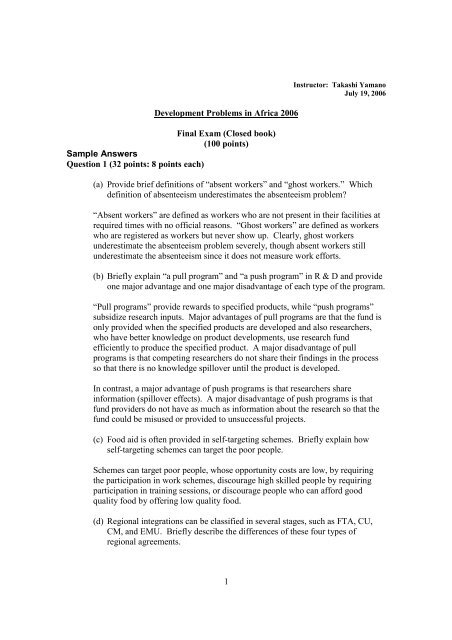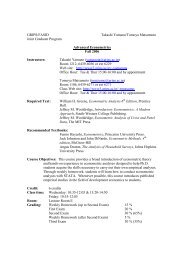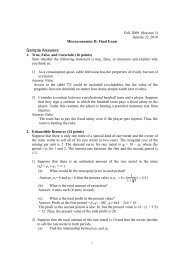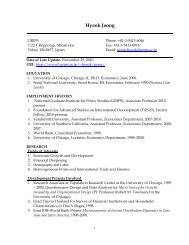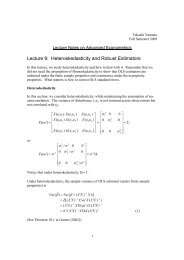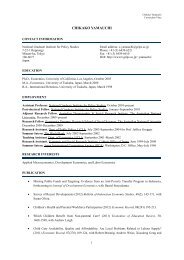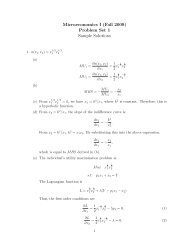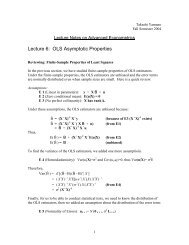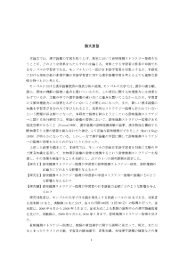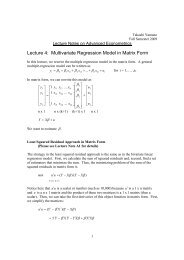1 Development Problems in Africa 2006 Final Exam (Closed book ...
1 Development Problems in Africa 2006 Final Exam (Closed book ...
1 Development Problems in Africa 2006 Final Exam (Closed book ...
- No tags were found...
You also want an ePaper? Increase the reach of your titles
YUMPU automatically turns print PDFs into web optimized ePapers that Google loves.
<strong>Development</strong> <strong>Problems</strong> <strong>in</strong> <strong>Africa</strong> <strong>2006</strong>F<strong>in</strong>al <strong>Exam</strong> (<strong>Closed</strong> <strong>book</strong>)(100 po<strong>in</strong>ts)Sample AnswersQuestion 1 (32 po<strong>in</strong>ts: 8 po<strong>in</strong>ts each)Instructor: Takashi YamanoJuly 19, <strong>2006</strong>(a) Provide brief def<strong>in</strong>itions of “absent workers” and “ghost workers.” Whichdef<strong>in</strong>ition of absenteeism underestimates the absenteeism problem?“Absent workers” are def<strong>in</strong>ed as workers who are not present <strong>in</strong> their facilities atrequired times with no official reasons. “Ghost workers” are def<strong>in</strong>ed as workerswho are registered as workers but never show up. Clearly, ghost workersunderestimate the absenteeism problem severely, though absent workers stillunderestimate the absenteeism s<strong>in</strong>ce it does not measure work efforts.(b) Briefly expla<strong>in</strong> “a pull program” and “a push program” <strong>in</strong> R & D and provideone major advantage and one major disadvantage of each type of the program.“Pull programs” provide rewards to specified products, while “push programs”subsidize research <strong>in</strong>puts. Major advantages of pull programs are that the fund isonly provided when the specified products are developed and also researchers,who have better knowledge on product developments, use research fundefficiently to produce the specified product. A major disadvantage of pullprograms is that compet<strong>in</strong>g researchers do not share their f<strong>in</strong>d<strong>in</strong>gs <strong>in</strong> the processso that there is no knowledge spillover until the product is developed.In contrast, a major advantage of push programs is that researchers share<strong>in</strong>formation (spillover effects). A major disadvantage of push programs is thatfund providers do not have as much as <strong>in</strong>formation about the research so that thefund could be misused or provided to unsuccessful projects.(c) Food aid is often provided <strong>in</strong> self-target<strong>in</strong>g schemes. Briefly expla<strong>in</strong> howself-target<strong>in</strong>g schemes can target the poor people.Schemes can target poor people, whose opportunity costs are low, by requir<strong>in</strong>gthe participation <strong>in</strong> work schemes, discourage high skilled people by requir<strong>in</strong>gparticipation <strong>in</strong> tra<strong>in</strong><strong>in</strong>g sessions, or discourage people who can afford goodquality food by offer<strong>in</strong>g low quality food.(d) Regional <strong>in</strong>tegrations can be classified <strong>in</strong> several stages, such as FTA, CU,CM, and EMU. Briefly describe the differences of these four types ofregional agreements.1
Please see the lecture notes.Question 2 (44 po<strong>in</strong>ts)Assume the follow<strong>in</strong>g conditions:Population: 100 personsAverage per capita (orig<strong>in</strong>al) <strong>in</strong>come: US$ 80Poverty: Headcount Ratio=0.4; Poverty Gap=0.3; Squared Poverty Gap=0.2Poverty l<strong>in</strong>e: US$ 50 per personAdm<strong>in</strong>istrative costs of target<strong>in</strong>g:⎧a(F − b)if 1 ≥ F ≥ bAC = ⎨(1)⎩−a(F − b)if b ≥ F ≥ 0where AC = Adm<strong>in</strong>istrative Costs <strong>in</strong> US$;F =Number of poor recipients/Total number of all recipients;a and b are coefficients, and a > 0 and 1 > b > 0.(a) (8 po<strong>in</strong>ts) Consider a safety net scheme that supplement people’ orig<strong>in</strong>al<strong>in</strong>come to br<strong>in</strong>g their total <strong>in</strong>come up to the poverty l<strong>in</strong>e. How much money isneeded to implement this scheme? (Consider only the amount of fund thatwill be provided to the people under the poverty l<strong>in</strong>e; no adm<strong>in</strong>istrative costs.)Poverty Gap x Poverty L<strong>in</strong>e x Number of population = 0.3 x $50 x 100 = $1,500Please see the sample answer of Mid-term <strong>Exam</strong> for details.(b) (8 po<strong>in</strong>ts) Expla<strong>in</strong> the <strong>in</strong>centive problems under the scheme <strong>in</strong> (a).People below the poverty l<strong>in</strong>e do not have work <strong>in</strong>centives because they canreceive $50 regardless of their orig<strong>in</strong>al <strong>in</strong>come.(c) (8 po<strong>in</strong>ts) Assum<strong>in</strong>g target<strong>in</strong>g is costly, f<strong>in</strong>d the value for b <strong>in</strong> equation (1)?Because the adm<strong>in</strong>istrative cost is the lowest when the aid is distributed randomly,the target<strong>in</strong>g level would be equal to the headcount ratio. Thus, b = 0.4.(d) (8 po<strong>in</strong>ts) Consider a uniform transfer scheme, where the scheme providesUS$ A to M recipients. Suppose the adm<strong>in</strong>istrative cost of target<strong>in</strong>g isdescribed <strong>in</strong> (1).(c-1) What is the total cost of this scheme?AM + a (F – 0.4) if F > 0.4,AM - a (F – 0.4) if F < 0.4,AM if F = 0.4(c-2) What is the total amount of fund received by the poor?2
AM is the total amount received by all recipients. Some of them are not poor.The proportion of poor is F. Thus, it isA M F(e) (12 po<strong>in</strong>ts) Suppose that the total fund available for the scheme is T. F<strong>in</strong>d theoptimal level of F that maximizes the total amount of fund received by thepoor for F ≥ b .Because the total fund is T, we haveT = AM + a (F – 0.4)AM = T - a (F – 0.4)The maximization problem ismax AMF = [T - a (F – 0.4)] F = TF - a F 2 + 0.4a FFOC w.r.t. F,T - 2aF + 0.4a = 0Thus, the optimal level of F isF* = (T + 0.4a) / 2a END(If $1,500 is available, as suggested <strong>in</strong> (a) and, let’s say, a is 3,000, then theoptimal level is 0.45. On the other hand, if a is 1,500, <strong>in</strong>dicat<strong>in</strong>g target<strong>in</strong>g isless costly, then the optimal level of target<strong>in</strong>g is 0.7.)Question 3 (24 po<strong>in</strong>ts: 8 po<strong>in</strong>t each)Note: Choose either A or B. If you presented one of the two papers, choose the otherpaper that you did not present.A. Short questions on “False Promise or False Premise?” by Jayne et al. (2002)(A1) What do “False Promise” and “False Premise” refer to <strong>in</strong> the article?“False Promise” refers to the expected agricultural growth after implement<strong>in</strong>greforms. “False Promise” refers to the assumption that reforms are actuallyimplemented. (See at the bottom of page 1968 of the paper.)(A2)Draw the two-by-two diagram that the authors used to make theirargument and briefly expla<strong>in</strong> the diagram.See the paper.(A3)What is the ma<strong>in</strong> f<strong>in</strong>d<strong>in</strong>g <strong>in</strong> the paper? Answer it with<strong>in</strong> 30 words.3
The authors f<strong>in</strong>d that many reform programs are actually not implementedas designed and propose a framework to expla<strong>in</strong> the degree of reformimplementations by the governments.B. Short questions on “Toward a Global Food Aid Compact” by Barrett and Maxwell(<strong>2006</strong>)(B1) Draw the two-by-two diagram that the authors used to make theirargument and briefly expla<strong>in</strong> the diagram.See the paper.(B2)The authors argue for complete unty<strong>in</strong>g of food aid, while Edward J. Clayargues for partial unty<strong>in</strong>g. Expla<strong>in</strong> the (DAC) def<strong>in</strong>itions of tied aid,partially tied aid, and untied aid referred by Clay.See footnote 4 of Clay’s response on page 120.(B3)Clay says that domestic <strong>in</strong>terests would oppose untied aid because itwould help their competitors. Expla<strong>in</strong> your answer by us<strong>in</strong>g thedef<strong>in</strong>itions <strong>in</strong> (B2).Under the untied aid, competitors of the donor country can procure the aid. Thus,Clay argue that domestic <strong>in</strong>terests of the donor country would oppose untied aid.4


